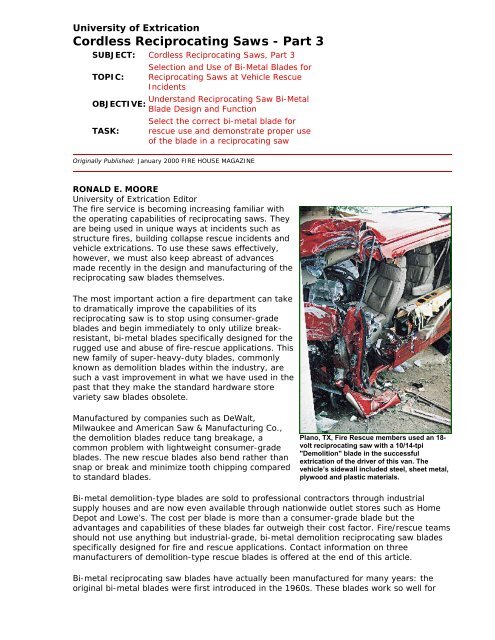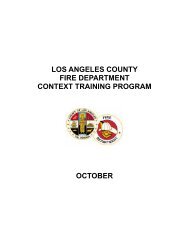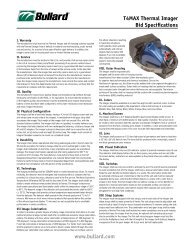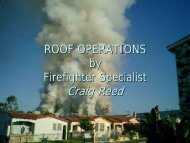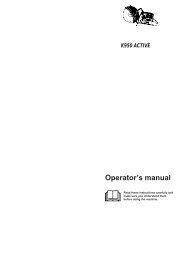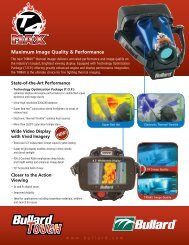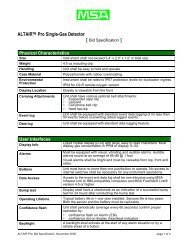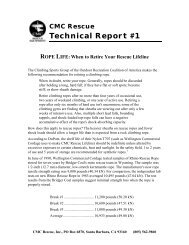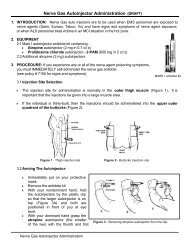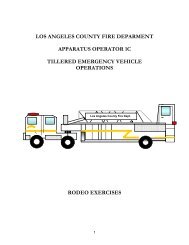University of Extrication- Reciprocating Saw Part 3.pdf 01/13/06 249 ...
University of Extrication- Reciprocating Saw Part 3.pdf 01/13/06 249 ...
University of Extrication- Reciprocating Saw Part 3.pdf 01/13/06 249 ...
Create successful ePaper yourself
Turn your PDF publications into a flip-book with our unique Google optimized e-Paper software.
<strong>University</strong> <strong>of</strong> <strong>Extrication</strong><br />
Cordless <strong>Reciprocating</strong> <strong>Saw</strong>s - <strong>Part</strong> 3<br />
SUBJECT: Cordless <strong>Reciprocating</strong> <strong>Saw</strong>s, <strong>Part</strong> 3<br />
Selection and Use <strong>of</strong> Bi-Metal Blades for<br />
TOPIC: <strong>Reciprocating</strong> <strong>Saw</strong>s at Vehicle Rescue<br />
Incidents<br />
Understand <strong>Reciprocating</strong> <strong>Saw</strong> Bi-Metal<br />
OBJECTIVE:<br />
Blade Design and Function<br />
Select the correct bi-metal blade for<br />
TASK: rescue use and demonstrate proper use<br />
<strong>of</strong> the blade in a reciprocating saw<br />
Originally Published: January 2000 FIRE HOUSE MAGAZINE<br />
RONALD E. MOORE<br />
<strong>University</strong> <strong>of</strong> <strong>Extrication</strong> Editor<br />
The fire service is becoming increasing familiar with<br />
the operating capabilities <strong>of</strong> reciprocating saws. They<br />
are being used in unique ways at incidents such as<br />
structure fires, building collapse rescue incidents and<br />
vehicle extrications. To use these saws effectively,<br />
however, we must also keep abreast <strong>of</strong> advances<br />
made recently in the design and manufacturing <strong>of</strong> the<br />
reciprocating saw blades themselves.<br />
The most important action a fire department can take<br />
to dramatically improve the capabilities <strong>of</strong> its<br />
reciprocating saw is to stop using consumer-grade<br />
blades and begin immediately to only utilize breakresistant,<br />
bi-metal blades specifically designed for the<br />
rugged use and abuse <strong>of</strong> fire-rescue applications. This<br />
new family <strong>of</strong> super-heavy-duty blades, commonly<br />
known as demolition blades within the industry, are<br />
such a vast improvement in what we have used in the<br />
past that they make the standard hardware store<br />
variety saw blades obsolete.<br />
Manufactured by companies such as DeWalt,<br />
Milwaukee and American <strong>Saw</strong> & Manufacturing Co.,<br />
the demolition blades reduce tang breakage, a<br />
common problem with lightweight consumer-grade<br />
blades. The new rescue blades also bend rather than<br />
snap or break and minimize tooth chipping compared<br />
to standard blades.<br />
Plano, TX, Fire Rescue members used an 18-<br />
volt reciprocating saw with a 10/14-tpi<br />
"Demolition" blade in the successful<br />
extrication <strong>of</strong> the driver <strong>of</strong> this van. The<br />
vehicle’s sidewall included steel, sheet metal,<br />
plywood and plastic materials.<br />
Bi-metal demolition-type blades are sold to pr<strong>of</strong>essional contractors through industrial<br />
supply houses and are now even available through nationwide outlet stores such as Home<br />
Depot and Lowe’s. The cost per blade is more than a consumer-grade blade but the<br />
advantages and capabilities <strong>of</strong> these blades far outweigh their cost factor. Fire/rescue teams<br />
should not use anything but industrial-grade, bi-metal demolition reciprocating saw blades<br />
specifically designed for fire and rescue applications. Contact information on three<br />
manufacturers <strong>of</strong> demolition-type rescue blades is <strong>of</strong>fered at the end <strong>of</strong> this article.<br />
Bi-metal reciprocating saw blades have actually been manufactured for many years: the<br />
original bi-metal blades were first introduced in the 1960s. These blades work so well for
escue applications because <strong>of</strong> their special rugged construction. They consist <strong>of</strong> two types<br />
<strong>of</strong> metal (thus the term bi-metal): a high-speed steel cutting edge that is welded to a<br />
strong, flexible spring steel back.<br />
The thin high speed steel edge contains all the<br />
teeth that do the cutting while the thicker<br />
main body <strong>of</strong> the blade, called the back, is<br />
specifically designed to help resist breakage<br />
during sawing operations.<br />
Blade Thickness Matters!<br />
Note how the reciprocating saw cut through all<br />
materials encountered on the van in Plano.<br />
fire-rescue applications.<br />
Another difference with the new demolition<br />
blade is apparent when one compares the<br />
standard blade to a new fire-rescue blade.<br />
Most hardware-store-variety reciprocating saw<br />
blades are .035 <strong>of</strong> an inch thick or less. Blades<br />
this thin may be acceptable for weekend jobs<br />
around the house, but they fail miserably for<br />
The new TORCH and AX blades from Milwaukee, for example, are .042 <strong>of</strong> an inch thick. Both<br />
the DeWalt and the Lenox line <strong>of</strong> Demolition blades are .<strong>06</strong>2 <strong>of</strong> an inch thick. When using<br />
these rescue blades, you will feel more resistance because the thicker blades is actually<br />
cutting more metal. You simply increase your pressure on the tool to <strong>of</strong>fset this resistance.<br />
Manufacturers produce blades with different numbers <strong>of</strong> cutting teeth because <strong>of</strong> the<br />
various types <strong>of</strong> materials that must be cut through. The number <strong>of</strong> teeth along each inch <strong>of</strong><br />
the blade is the referred to as the blade’s tooth-per-inch (tpi) rating. A high tpi number such<br />
as 18 or 22 indicates a fine-tooth blade, one with many small teeth along its cutting edge.<br />
This blade is used by builders or contractors to make detailed cuts in thin metal, plastic or<br />
laminate materials.<br />
Fine-tooth 18 or 22 tpi reciprocating saw<br />
blades serve no useful purpose for vehicle<br />
rescue applications. The cutting teeth are too<br />
small and too fine for the thickness and<br />
layering <strong>of</strong> metal being cut through at<br />
extrication scenes. An 18-tpi blade will not last<br />
long enough at a crash scene to perform<br />
effective cutting. Using a blade that is too fine<br />
for the job also causes it to cut more slowly<br />
and to wear out rapidly.<br />
For the majority <strong>of</strong> vehicle rescue applications,<br />
a medium tpi blade is the best to use.<br />
<strong>Extrication</strong> crews should consider<br />
standardizing on using the new bi-metal<br />
blades rated between 10 and 14 tpi.<br />
Rescue crews should use only the new generation <strong>of</strong><br />
rugged blades manufactured specifically for fire-rescue<br />
applications.<br />
To make it even easier to standardize on blade choice for rescue applications,<br />
manufacturers now produce "variable tooth" blades. These are very versatile for our vehicle<br />
rescue applications. A typical “vari-tooth” blade has a rating <strong>of</strong> 10/14 tpi. This means that<br />
throughout the length <strong>of</strong> the blade, the tpi changes back and forth from the finest setting <strong>of</strong><br />
14 tpi to a coarse setting <strong>of</strong> 10 tpi. These variable-tpi blades are the most efficient allaround<br />
fire rescue blade available. If you only had one blade style to stock in your inventory<br />
for vehicle rescue, they should be variable tooth 10/14-tpi blades.
To cut through wood such as a tree limb or structural lumber, a coarse-tpi saw blade with a<br />
tpi <strong>of</strong> 6 or less would be used. I have also used 6-tpi blades for cutting sheet metal along<br />
the side panel <strong>of</strong> a vehicle. With a 12-inch-long, 6 tpi blade, I can completely cut out the<br />
“third door” <strong>of</strong> a two-door vehicle along with the B-pillar. This aggressive cutting allows the<br />
entire sidewall, B-pillar and door to open on the front door’s hinges.<br />
Cutting vehicle metal with a blade designed for wood, however, causes a lot <strong>of</strong> saw vibration<br />
and is noisy. But with a well-prepared and properly trained rescuer, it results in an<br />
aggressive attack that will quickly open up the entire side <strong>of</strong> a damaged vehicle. This is not<br />
the blade <strong>of</strong> choice for tubular metal, pipes or even narrow ro<strong>of</strong> pillars. For sidewalls or the<br />
base area <strong>of</strong> a B-pillar however, the 6-tpi blade is an exciting alternative. Grab hold, hang<br />
on and be impressed!<br />
Besides the routine metal cuts through vehicle components such as ro<strong>of</strong> pillars with 10/14-<br />
tpi blades, a reciprocating saw can be very effective in totally removing a vehicle’s<br />
windshield. When cutting laminated glass, a coarse-tpi blade is better. Use a 6-tpi or a<br />
variable tooth 10/14 for best results on the windshield. The finer teeth <strong>of</strong> a straight 14- or<br />
18-tpi metal cutting blade dulls quickly as the glass is cut. Any reciprocating saw blade that<br />
is used to cut out a windshield should be discarded after the windshield evolution is<br />
completed because the cutting edges <strong>of</strong> the teeth will be significantly dulled.<br />
Recommended Lengths For <strong>Extrication</strong> Blades<br />
Crews using reciprocating saws for any <strong>of</strong> a wide variety <strong>of</strong> fire-rescue applications should<br />
stock three basic lengths <strong>of</strong> saw blades in their inventory. The shortest blades should be sixinch-length<br />
units. These would be used only when there is limited clearance or when a<br />
longer blade can not fit into an opening.<br />
The most effective length blade for all purpose vehicle rescue applications is the eight- or<br />
nine-inch blade. Fire departments should make the eight- or nine-inch blade their standard<br />
rescue attack blade and pre-blade their saw with this length. This versatile length blade cuts<br />
best through the multiple layers <strong>of</strong> material found in vehicles today; thick rear ro<strong>of</strong> pillars,<br />
side B-pillars, door panels, etc.<br />
For unique circumstances, rescue teams should stock a minimum number <strong>of</strong> 12-inch-length<br />
blades also. These special-purpose blades are useful when cutting through some thick<br />
object such as the base <strong>of</strong> a B-pillar on a full-size sedan, the entire sidewall panel <strong>of</strong> a twodoor<br />
coupe or the side <strong>of</strong> a van. With the longer length blade, it is possible to cut through all<br />
layers at the same time. The protruding end <strong>of</strong> this blade, however, may be too long to be<br />
used near a patient. There is one more caution when using this long length blade. If a 12-<br />
inch blade is used to cut through a thin wall material, the extra length <strong>of</strong> the tip causes the<br />
blade to “wag” back and forth. This wagging causes the material being cut to also vibrate<br />
and reduces the cutting efficiency <strong>of</strong> the saw.<br />
For every quantity <strong>of</strong> reciprocating saw blades that a fire department stocks on its rescue<br />
vehicles, the majority <strong>of</strong> them should be eight or nine inches in length. We should always<br />
have available two or three blades that are six inches in length and another two or three<br />
that are extra-length 12-inch blades.<br />
If I could only have 12 saw blades with me on a rescue call, I’d want eight <strong>of</strong> them to be<br />
eight-inch, 10/14-tpi blades. I’d want two more to be 12-inch, 6-tpi blades and the final two<br />
to be 6-inch 10/14-tpi blades. This selection would be the basis <strong>of</strong> my saw blade starter kit.<br />
No Blade Lubrication During Vehicle Rescue!
Cutting through certain hardened metals with a reciprocating saw can produce small sparks.<br />
This is due to the overheating <strong>of</strong> the metal being cut. Blade manufacturers instruct<br />
industrial saw users to lubricate saw blades with cutting oil when using a reciprocating saw.<br />
The manufacturers’ engineers explain that lubrication at the point <strong>of</strong> cutting makes for an<br />
easier operation and provides a longer blade life.<br />
Firefighters, seeing these recommendations, have for years lubricated reciprocating saw<br />
blades at vehicle rescue incidents. When we used actual cutting oils, we found that the<br />
friction <strong>of</strong> the saw blade as it cuts produced a smoke that smelled like something was<br />
burning. This was not good for a conscious patient to smell while trapped inside a vehicle.<br />
So the “cure-all” solution was introduced: soapy water. It doesn’t smoke, it’s cheap and it<br />
appears to work.<br />
The blade’s tooth-per-inch rating should not exceed 14<br />
tpi for metal cutting and should be 6 tpi when cutting<br />
wood.<br />
Field research conducted by this author has<br />
determined that lubrication <strong>of</strong> a reciprocating<br />
saw blade during vehicle rescue incidents does<br />
not noticeably improve cutting speed or the<br />
efficiency <strong>of</strong> the cutting action. In addition,<br />
applying soapy water from a squeeze bottle<br />
ties up a rescuer that could be better put to<br />
work doing something productive. Without<br />
lubrication, you do get additional heat around<br />
the teeth, which s<strong>of</strong>tens them. Blades will<br />
have to be changed more <strong>of</strong>ten, but with the<br />
new saws having a keyless chuck, a blade<br />
change takes less then three seconds to<br />
complete.<br />
Under fire-rescue applications, I recommend<br />
NOT lubricating the blade <strong>of</strong> a reciprocating saw. We are not interested in saving money by<br />
prolonging the life <strong>of</strong> the blade as the owner <strong>of</strong> a machine shop would be. We’ll throw our<br />
used blades away when we return to quarters and will come to the next extrication call with<br />
a fresh blade installed in the saw. Don’t waste your time or your personnel lubing a blade!<br />
Lubrication is recommended, however, for the reciprocating saw itself. Tools used under<br />
real-world rescue applications can quickly accumulate foreign materials inside the working<br />
components <strong>of</strong> the saw especially at the blade clamp area. Periodic cleaning, inspection and<br />
lubrication <strong>of</strong> the saw at an authorized service center will increase the reliability <strong>of</strong> the tool<br />
and prolong its useful life span.<br />
Proper Cutting Procedures<br />
Here are some general guidelines to consider when working with a reciprocating saw at firerescue<br />
incidents:<br />
Blade Manufacturers Contact<br />
Information<br />
Lenox brand bi-metal "DEMOLITION"<br />
blades are available from:<br />
American <strong>Saw</strong> & Manufacturing Co.<br />
3<strong>01</strong> Chestnut St.<br />
PO Box 504<br />
East Longmeadow, MA <strong>01</strong>028-0504<br />
800-628-3030<br />
www.lenoxsaw.com
• Hold the saw firmly with both hands, but only by the<br />
insulated gripping surfaces, when performing a cutting<br />
operation. Unintentional contact with a “live” energy source,<br />
such as a wire <strong>of</strong> the vehicle’s electrical system, can<br />
energize the exposed metal parts <strong>of</strong> the entire tool. This will<br />
cause shock to the saw operator if your hands are<br />
incorrectly placed on the bare metal <strong>of</strong> the tool.<br />
• If you have a variable-speed reciprocating saw, select the<br />
proper speed for the material being cut. As a general rule,<br />
with harder metals such as cast door hinges or Nader pins,<br />
a slower saw speed will be more effective. A lower speed<br />
setting, approximately 1,500 strokes per minute, is good for<br />
most metal cutting. Increasing the motor speed to full does<br />
not get a significant improvement in cutting speed. Slowing<br />
the blade speed down increases blade life and does not<br />
reduce overall cutting time.<br />
• With a variable-speed feature on your saw’s trigger,<br />
"feather" the speed to give you the best performance. If<br />
you have to work only at the high-speed setting on your<br />
Bi-metal "Demolition" blades<br />
are available from:<br />
DeWALT Industrial Tool Co.<br />
7<strong>01</strong> E. Joppa Road<br />
Towson, MD 21286<br />
800-892-4776<br />
www.dewalt.com<br />
Bi-metal "The TORCH" and<br />
"The AX" blades are available<br />
from:<br />
Milwaukee Electric Tool Corp.<br />
<strong>13</strong><strong>13</strong>5 West Lisbon Road<br />
Brookfield, WI 53005-2550<br />
414-781-3600<br />
www.mil-electric-tool.com<br />
saw, adjust your grip to a moderate pressure on the material being cut. Relaxing the<br />
pressure slightly will actually allow the blade to cut faster and to last through the entire<br />
cutting action.<br />
• Whenever possible, the saw shoe must be held firmly against the material being cut. This<br />
will prevent the saw from jumping or vibrating and will minimize damage to the blade’s<br />
teeth. Not keeping the foot <strong>of</strong> the saw in contact with the material being cut is the number<br />
one reason for ineffective reciprocating saw cutting at crash scenes.<br />
• Do not force the tool or bind the blade. This diminishes battery life on cordless<br />
reciprocating saws. Create a rocking action by moving the body <strong>of</strong> the saw up and down as<br />
you cut while the foot remains in contact with the material being cut. Maintain the<br />
appropriate pressure against the material for the most effective cutting action.<br />
• Protect yourself and your patient during the operation <strong>of</strong> the saw. Rescue personnel<br />
should don appropriate personal protective equipment (PPE), including safety glasses or<br />
goggles. Patients should have "hard" protection such as a KED or XP-1 immobilization board<br />
placed between them and the cutting blade.<br />
• Blades are hot immediately after operation. Do not grab a used blade by the working end.<br />
Open the blade clamp and allow the blade to fall out <strong>of</strong> the end. Burns on fingertips are<br />
painful!<br />
• Avoid accidental saw starting. Be sure the safety switch is in the locked position before<br />
making adjustments to the tool, inserting a fresh battery pack or changing the saw blade.<br />
Store your saw with the safety in the "locked" or "on" position.<br />
• Do not operate a corded or cordless power tool in an explosive atmosphere. Power tools<br />
create sparks internally and externally, which may ignite dust or flammable vapors present<br />
in the area.<br />
• For teams working with the newer generation <strong>of</strong> cordless reciprocating saws, remember<br />
to protect the exposed battery terminals from contacting any metal objects such as nails or<br />
screws. Metal across the terminals will short the battery out and may cause sparks, burns or<br />
a battery fire.


